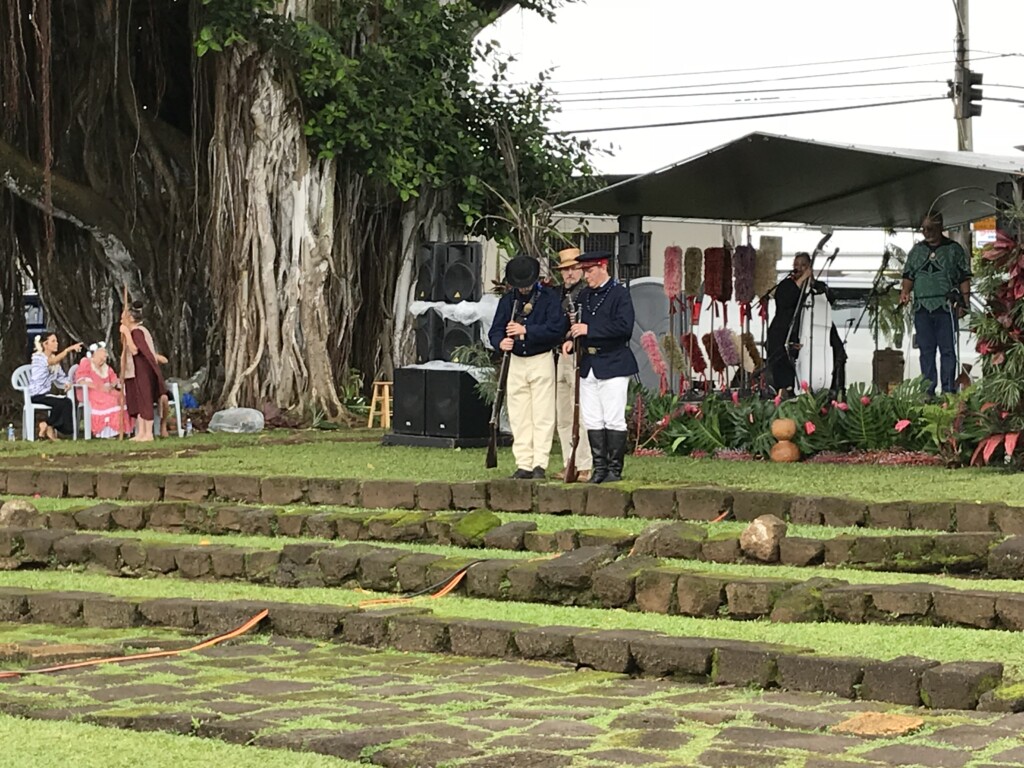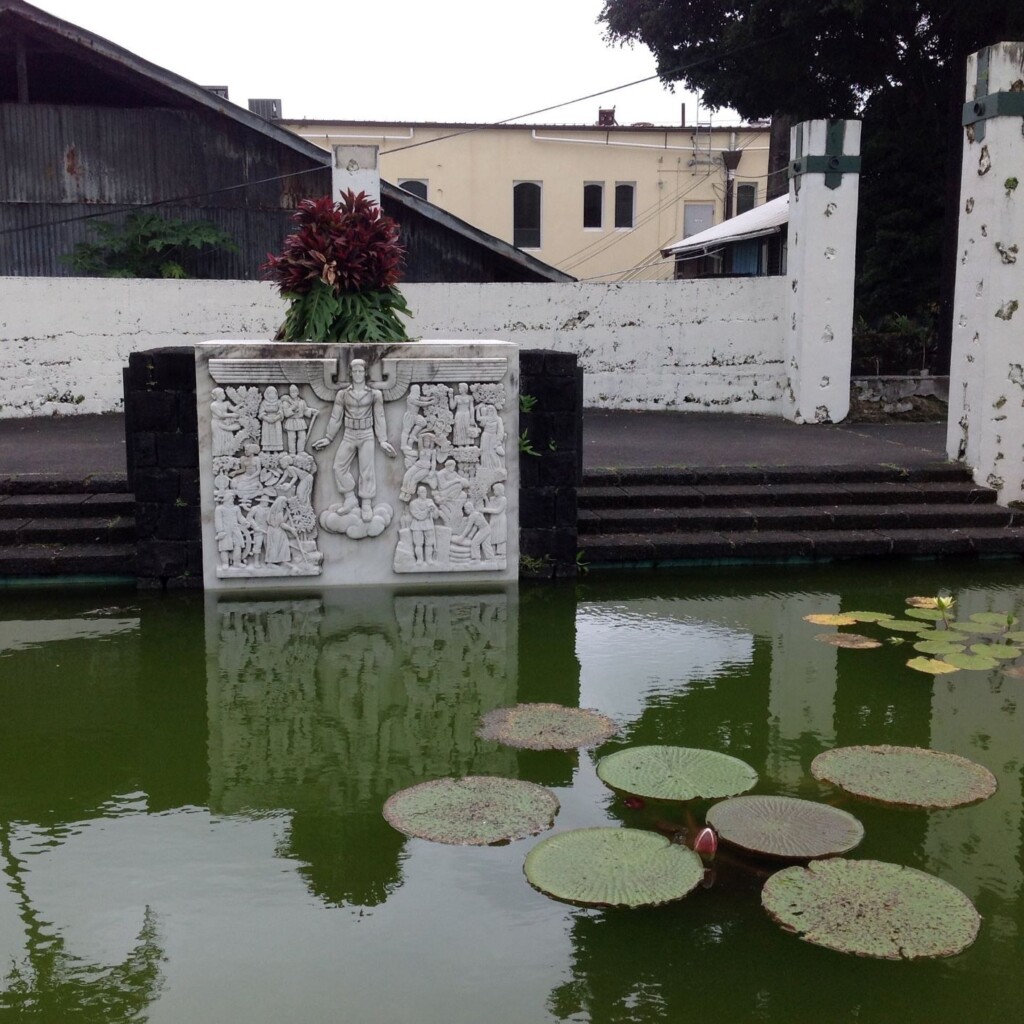The Project: Repair and Restoration of Historic Stonework and Interpretive Signage
Congratulations to newly formed Friends of Kalākaua Park (FOKP), one of the latest recipients of the Hilo Preservation Grant Program (learn more about this program at the end of this post). The grant will be used for repair and restoration of the historic stonework and interpretive signage at Kalākaua Park located at 136 Kalākaua Street in downtown Hilo as steps to eventually restore the site to its original magnificent condition. Over the years research on the site’s history has been conducted by community members and other stakeholders dedicated to preserving the rich history of community places in Historic Downtown Hilo for future generations. In 2009, the Hilo Downtown Improvement Association installed two interpretive signs at Kalakaua Park and at the Naha/Pinao stones in front of the Hilo Public Library. Several years ago the interpretive sign for the Park went missing, and part of the project aims to reinstall the proper signage.
Marcia Timboy of FOKP who serves as project manager, shares the larger goal is to preserve the area as a significant part of Hilo’s history while continuing to build partnerships with all the groups who presently use the site and encouraging further usage by the broader community. She is passionate that the revitalization will enliven downtown Hilo by eventually re-establishing Kalākaua Park as the lively town square it once was.
This vision has a lot of community support from local organizations including Friends of Lili‘uokalani Gardens (who is also FOKP’s fiscal sponsor), East Hawai`i Cultural Center, Big Island Water Garden Club, Hawai`i Island Chamber of Commerce, Hawai`i County Council, Hilo Women’s Club, Destination Hilo, and downtown Hilo businesses.
I recently had the chance to video chat with Marcia to learn more.
The Grant Project and Longer Term Vision for the Park
The project is based on the importance of the area as a town square and Marcia explains that even before it was in its current incarnation as Kalākaua Park, the area was a complex of ancient pre-contact governance in Hawaii especially important to Moku O Keawe.* Marcia shares that there are many, many stories and legends related to this wahi pana including one recalling how Kamehameha came up the Wailuku River to meet with the chief of Hawai‘i Island here and another, a legend connected to the origin of the twisted ti leaf lei known as the Hilo lei. She emphasizes the rich history adding that Queen Ka‘ahumanu had a residence here and was known to walk up to the Lyman House (2 blocks up). Indeed, the historically recorded pathway from Kalākaua Park up to Lyman House still exists.
Marcia reiterates that the newly formed Friends of Kalākaua Park recognizes the importance of being able to connect people in their present lives to a place through the history. “I think it’s so important for people to know the history of a place in order to feel a sense of the place and be a part of it,” Marcia notes. “Then people begin to take ownership of it and care for the place as their own.” She continued, “somewhere I have pictures of my parents and grandparents in the park showing there were all kinds of events there—it was truly a town square, the center of Hilo. A lot of festivals, events, activities happened there and we just want to see that happen again.”
Once example of the resurgence in recent years is the annual Lei Day Festival which began again about 16 years ago. FOKP hopes efforts to revitalize the park will help residents gain a deeper sense of place which will lead to more of them taking on a sense of ownership—a kuleana to help it thrive.
Marcia shares how she became involved with the project:
“I was born in Kona and moved to Hilo when I was 4 because my dad was attending what was then called Hilo Business College. We went to KP because we lived downtown. People wore aloha attire and lei whenever they went out. I recall photos of my grandparents and parents from the Park.
I lived on Oahu for many years and moved back to Hilo and was asked to help with the Lei Day festival and that’s how I became involved with Kalākaua Park. I love lei making. And then I started really learning about the history of the area. I found some photos from the festival from the 1940s—back then people gathered for events. KP was really the gathering place for Hilo.”
Marcia continues,
“The stonework is just beautiful. Over the years people just walk by and don’t even notice. I was so excited when I came onto the project thinking it was pre-contact but it was built in 1930. It’s based on Polynesian stonework and we have a Big Island mason who is familiar with this type of work. He likes to work with lava rock. And we’re thrilled to have LoriAnn Gordon, the landscape architect, working with us. She was very excited and immediately said ‘Yes! I would love to work on this.’ She began doing her own research.”
Currently, in addition to the Lei Day Festival which had to be cancelled this year due to the COVID-19 pandemic, Shakespeare in the Park has been held here for the past 35 years. The Hilo Community Players produce it. FOKP would like to see more events like these.
Sadly Marcia notes how the Park has become less safe and ignored. FOKP is hoping to revitalize the park, share its history and lift up the energy so it becomes safe to be downtown. And the park is the core of the downtown and a richly historical site which includes a beautiful pond and a marble monument honoring Hawaiʻi Island veterans who died in World War II, the Korean War, and Vietnam.
Another wonderful element of the project is the community collaboration that exists to revitalize this special place. It’s a true joint vision with many groups vested in the rebirth of this special historic gathering place.
Marcia’s final words, “Mahalo nui loa HHF and funders for supporting this project!”
*Moku O Keawe – The Island of Keawe recalls and honors a 17th-century chief, Keaweʻīkekahialiʻiokamoku (Keawe the One Chief of the Island,”) whose reign was ascribed “such peace and prosperity as the island of Hawai‘i had not enjoyed since the time of his ancestor Līloa”. (Barrere, deSilva) Today we know it as Hawai‘i Island. Source: http://totakeresponsibility.blogspot.com/2014/09/moku-o-keawe.html
The Hilo Preservation Grant Program, initiated in 2019, supports historic preservation as a vehicle for building community, enhancing Hawaii’s sense of place, and helping to revitalize the historic downtown Hilo. Grants are awarded for preservation, rehabilitation, restoration and beautification of historically significant buildings and structures in the core downtown area. The next grant deadline is August 3, 2020. Learn more and apply.
By Andrea Nandoskar, Education Program Manager.





